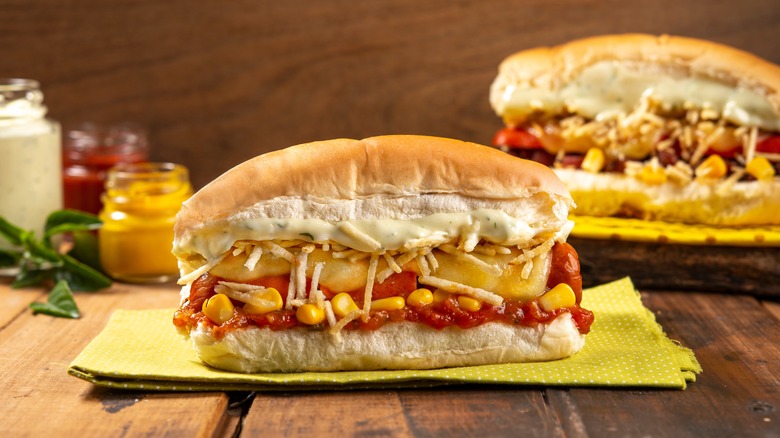The Cooking Method That Separates Brazilian Hot Dogs From The Rest
Few foods are considered more classically American than hot dogs. Even if the true origins of hot dog buns are shrouded in mystery, these delicious meat tubes came from Germany, and they've been fodder for international jokes about Americans ever since. Since the first Coney Island stand opened in 1871, hot dogs have been staple of the American landscape, even if the true origins of hot dog buns are shrouded in mystery.
But America isn't the only country famous for its hot dogs. In particular, there's one nation that has its own unique spin on the classic food that brings a whole new flavor profile to the table: Brazil. Properly known as cachorro quentes, Brazilian street hot dogs bring tons of unique topping mixes to the table. They also utilize a cooking method quite unlike anything you're likely to find in America: They're simmered in tomato sauce. This may take longer to cook and require a little more effort than tossing a Nathan's frozen hot dog into the microwave or a boiling pot of water, but the end result creates a flavor explosion that has to be tasted to be believed.
Both the cooking method and toppings are important
Preparing cachorro quentes isn't actually all that complicated. Typically, they're cooked in a pan with oil, seasonings, and a tomato-based sauce (and maybe some of the toppings you plan to use) on low heat, and the meat is often cut into pieces so it absorbs as much flavor as possible. Though the end result may taste a bit different than an American hot dog, cachorro quentes are still meat on a bun, meaning they're definitely a solid entry into the Worldwide Hall of Hot Dogs (which will have a permanent location any day now just as soon as Hebrew National starts answering our calls).
The toppings for cachorro quentes are just as important, and there's an extensive list of possibilities. Peppers and onions certainly won't seem strange to American audiences, but they goes beyond that to include things like the tomato sauce, ground beef, ham, potato sticks known as batata palha, parmesan, peas, cilantro, quail eggs, corn, and even mayonnaise. But while topping variety means cachorro quentes can vary a lot in overall flavor profile, it's that tomato sauce simmer that really gives them their signature taste.
There are plenty of other unique regional hot dogs, too
Brazil isn't alone in the hot dog game, either. Though cachorro quentes are certainly a unique spin on the classic, there are plenty of other countries that have their own takes, contributing to the host of unique hot dogs from around the world. Brazil's great football rival Argentina has Panchos Argentinos, in which a hot dog is sliced down the middle lengthwise, then coated with toppings like mayonnaise, mustard, and chimichurri. Icelandic hot dogs feature capers, mustard, gherkins, and anchovies, while Vancouver, Canada has "japadogs" made with all sorts of Japanese ingredients, from teriyaki sauce to seaweed and bonito flakes. And Korean corn dogs, or "gamja dogs," are rolled in all sorts of savory or sweet add-ons, from white sugar to literal potatoes.
No matter where you go around the world, chances are somebody has thought of a unique way to enjoy a hot dog. The lifelong mission to try them all continues.


